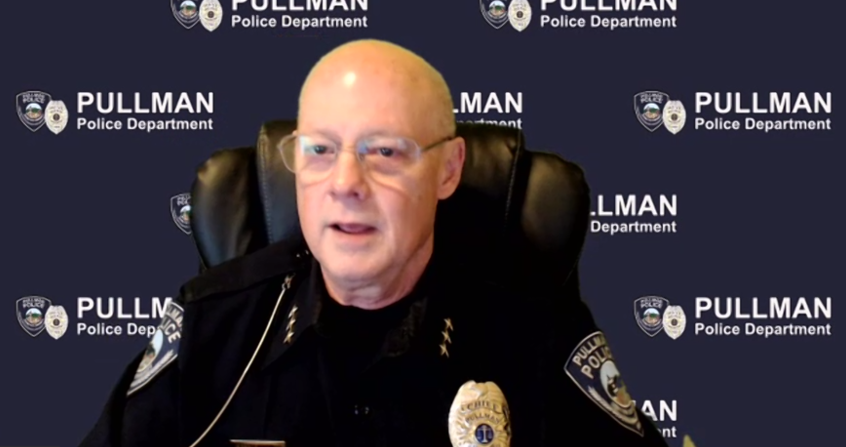- Administration
- COVID-19
- Faculty
- Features
- Greek
- Local
- News
- Pullman Community
- Safety
- TOP FEATURES
- WSU Pullman campus
Community discusses Pullman public safety during virtual summit
Police departments implement body-worn cameras, use of force training; considering Citizen Police Academy, public survey
Pullman Police Chief Gary Jenkins said his department is reviewing their policy to ensure officers’ use of force is appropriate for the incidents they are being used.
November 10, 2020
Over 70 people attended the Reimagining Public Safety in Pullman Virtual Summit on Monday night to discuss local police departments’ approach to use of force, officer accountability and a community-oriented policing model.
Pullman Police Chief Gary Jenkins and WSU Police Chief Bill Gardner discussed their respective department’s policies and training during the event organized by the Pullman Police Advisory Committee. Individuals participated in breakout room sessions to discuss their thoughts on public safety in Pullman.
Use of force
Jenkins said the Pullman Police Department had controversial incidents over the last few years regarding use of force. He said his department is reviewing their policy to ensure officers’ use of force is appropriate.
“Our use of force was lawful. It was within policy,” he said. “But I didn’t like the result of what was happening.”
He said there needs to be more discussion on use of force to help the Pullman PD understand how the community perceives the department.
There are standards for how use force incidents are investigated, Jenkins said, because of Initiative 940, also known as the Police Training and Criminal Liability in Cases of Deadly Force Measure.
The 2018 initiative requires law enforcement agencies to provide at least weekly updates concerning use of force incidents and to assign a liaison to the family of the individual involved in the incident, he said.
The initiative also requires training for de-escalation, mental health, implicit bias and cultural competency. Jenkins said the training includes learning how to properly interact with people with disabilities.
In one of the breakout sessions, an attendee said monitoring reports on use of force is important to ensure officers are held accountable and training is implemented effectively.
Pullman PD officers have been using body cameras since 2013. Jenkins said the cameras act as transparency and accountability tools for officers, which allows police departments to conduct objective reviews of incidents captured by the cameras.
WSU PD has used body cameras since 2012. Gardner said officers were initially anxious about the BWCs because they were self-conscious of being on camera.
“They’ve been a huge help to us in many, many ways, mostly because they help set a context when there’s any type of question about officer conduct … or an incident where an officer was involved,” he said.
Both departments use a similar approach when handling complaints. Jenkins said complaints are referred to the officer’s supervisor. Depending on the nature and the seriousness of the complaint, disciplinary action could lead to termination.
Another transparency tool the police departments use is their ride-along programs. Gardner said ride-alongs are great opportunities for the public to view law enforcement through a different lens. Currently, ride-alongs are temporarily suspended because of COVID-19.
Investigating sexual assault cases
A few years ago, Gardner talked to survivors of sexual assault and received their feedback about how WSU PD handled sexual assault cases. He said he realized WSU PD was not consistent in how it was investigating those cases.
“Investigations were being done,” he said, “but we weren’t consistent in how we were doing them.”
During a breakout session, an attendee proposed that officers should have face-to-face interactions with survivors and converse with them to understand what they are doing right and what they can do better.
“At the chief level, that’s pretty powerful,” the attendee said. “But are the officers hearing from survivors?”
Other developments
Jenkins said Pullman PD is looking at developing a Citizen Police Academy. They are currently in the process of searching for grants to fund the program.
In addition, a community survey is under development. The survey will ask community members their thoughts on public safety in Pullman, he said.
An attendee said the police departments need to reevaluate how they will approach the surveys, especially regarding sensitive topics like sexual assault.
“I think we also need to be really mindful as to how they do that because you are asking someone to speak truth to power in a way they might not have had the opportunity to do before or might still have hesitation to,” the attendee said.
The survey and the academy are part of the departments’ focus and implementation of the community-oriented policing model. Jenkins said his department is transitioning from a statistical-driven performance model to that of a problem-solving model.
The former model was based on quantity, like the number of arrests, he said, which did not necessarily mean Pullman PD was solving community safety issues.
“We’re just not looking at numbers,” Jenkins said. “We’re looking at the quality of our contacts that we have with the public and their ability to work collaboratively with the community to solve problems.”
Gardner said WSU PD does not base its evaluation of officers on numbers alone.
In one of the breakout rooms, an attendee said WSU PD seems to be “out to get students.” The attendee shared stories of how WSU PD officers would wait in certain areas to issue minors intoxicated in public who were coming back from College Hill. WSU PD’s behaviors seem to contradict Gardner’s statement, the person said.
Another attendee recommended that WSU PD consider participating in a counter bias training simulation. This training can be added to the WSU Police Advisory Board’s Civil Rights Action Plan, which was a recommendation listed in the Compliance and Civil Rights’ May 2020 investigative report.
In the report, CCR found that Black people “were four times more likely to be arrested than those who identified as white” and were more likely to be arrested than other minorities. The CCR investigation was prompted by a Daily Evergreen article.
The attendee said Pullman PD needs to reevaluate how it balances its community-policing model with enforcement, especially concerning pandemic violations at Greek Row.
Pullman Police Advisory Committee Chair Stephanie Rink said facilitators in the breakout rooms took notes of people’s feedback. A committee will compile all notes into a single document, outlining issues and potential solutions, turning them into action items for the WSU and Pullman police departments.
She said PPAC will review the document during its February meeting. The meeting will be open to the public.










